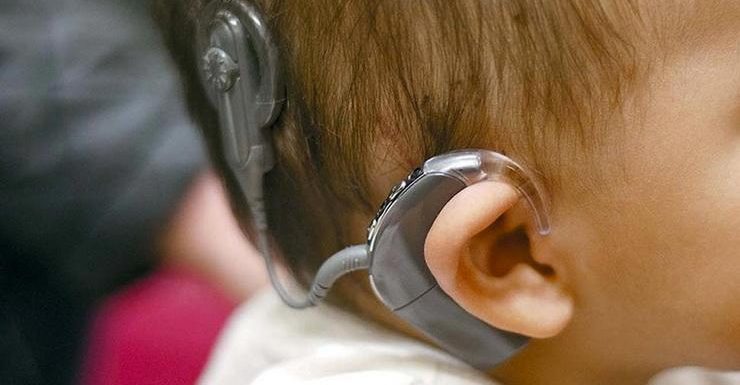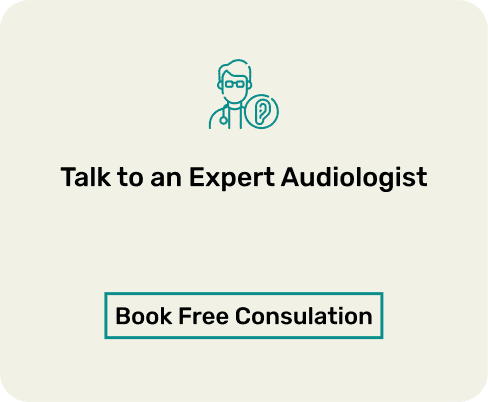You might come across a mention of cochlear implants as an alternative for treating hearing loss. Cases requiring cochlear implants are usually very different to those requiring Hearing Aids.
Cochlear Implants are considered only in cases where hearing aids are not successful or where hearing aids are not possible.
Cochlear implants come the closest to recreating natural sounds. They are more conspicuous as compared to hearing aids, which are available in multiple styles and sizes. Let’s take a look at which is the better option for you- cochlear implant vs hearing aid.
Cochlear Implant vs Hearing Aid
Here’s a step-by-step analysis of how hearing aids and cochlear implants differ from each other.
1. Cochlear Implant vs Hearing Aid – How Does Each Work?
A cochlear implant has both internal and external parts. The internal parts-the electrodes and the receiver-stimulator – are implanted by a surgeon. The surgeon places the electrode array in the cochlea, bypassing the damaged hair cells, and the receiver stimulator is implanted just behind the ear.
The external portion consists of a microphone, processor, and transmitter that sits behind the ear, similar in style to a behind-the-ear hearing aid.
To know more about how cochlear implants work, refer to the article here.
A hearing aid has three basic parts: a microphone, an amplifier, and a speaker. The hearing aid receives sound through a microphone, which converts the acoustic (sound) signals into electrical signals and transmits them to the amplifier.
Read this to learn more about how hearing aids work.

2. Hearing Aids Vs Cochlear implants – Who Can Use Them?
Most cochlear implant recipients try hearing aids first, prior to surgery. If hearing aids do not provide maximum benefit, due to reduced cochlear function or poor speech discrimination, cochlear implant surgery is considered. Determining cochlear implant candidacy often involves audiological testing, medical examination and X-rays/MRI. Most recipients have a profound sensorineural hearing loss or congenital deafness. Let’s look at the suitability of cochlear implants in detail.
Adults: Cochlear implants are suitable for adults of any age, where they have developed speech (post-lingual cases) and when hearing aids are either not helping at all, or the speech discrimination score of the adults with hearing aids is less than 40%. This would usually be in the case of severe-to-profound hearing loss.
Children: Cochlear implants in children can be further divided into pre-lingual and post-lingual.
- Pre-lingual: These are cases where the child has not yet learned to speak. In such cases, cochlear implant surgeries have the best results if the child is implanted as early as possible, preferably within 5 years of age. After the age of 5, the child’s ability to develop speech reduces drastically. After the age of 7, you could at best only expect the child to develop an awareness of sound with the implants. This, too, could be useful for children suffering from profound deafness.
- Post-lingual: These refer to cases where the child has already developed speech. In such cases, the implant can be done at any age but preferably soon after having lost their hearing.
Children as young as 12 months can be implanted.
It is important to note that cochlear implants are not suitable for the following:
- In cases where a candidate has a mild, moderate, or severe hearing loss and can discriminate over 40% of spoken words with or without hearing aids.
- Some cases of deformed cochlea
- Some cases of retrocochlear pathologies (occurring at the central or neural nerve that causes hearing impairment).
3. What are their Purposes:
Although hearing aids and cochlear implants serve the same purpose, there are differences between them.
Hearing aids deliver amplified sound to the damaged cochlea. Depending on the type of loss, be it the common ski-slope shaped hearing chart (high frequencies are most severely impacted) or reverse slope loss (low frequencies are impacted), a hearing aid can be programmed to shape the amplification of sound to match the loss. The sound is still being delivered to damaged nerves, so hearing aids are limited in ability to aid severe and profound loss beyond environmental sound and vowels in speech. The use of a hearing aid at the severe and profound level can be deceptive in the perceived benefit due to the fact you ‘can still hear.’
Modern hearing aids can do a lot of processing, including compensating for hearing loss that varies at different frequencies and improving performance in noise. But in the end, they can only present the sound to you by yelling in your ear. The signal is still processed by the damaged cochlea and sent to the brain with its added distortion. Even with substantial amplification, you may not hear very much, and you become tired and strained due to the loud sounds being presented to your ear.

Cochlear implants operate very differently than hearing aids. A cochlear implant bypasses the damaged hair cells by delivering electrical current directly to the cochlea, or auditory nerve. A cochlear implant presents a wide range of frequencies, regardless of the pre-implantation hearing loss.
4. The Primary Benefits:
The primary benefit of hearing aids over cochlear implants is in the area of low frequencies. Low frequencies are detected at the apex (innermost area) of the cochlea. Current implant technology limits the insertion depth of the electrode into the cochlea, limiting access to the lower frequencies below 250 Hz. Those who are able to use a hearing aid in one ear and an implant in the other are encouraged to do so for this reason. Users who rely solely on an implant to hear find that they gain access to low frequencies via harmonics once the brain has learned to translate the electrode signals.
People who transition from hearing aids to cochlear implants generally find that compensation techniques such as lip-reading become easier. Eventually, you may reach a point where you require very little compensation.
5. The Adjustments:
With hearing aids, many people try to increase the volume as much as possible. With severe or profound hearing loss, this may provide some cues to aid in reading lips and interpolating contextual cues. Cochlear implants provide plenty of sounds, so that you don’t need to have high volumes blasted into your ear just to get those sounds. Your job is to learn how to interpret them so that it becomes second nature.
Many types of hearing loss involve more loss at high frequencies. This is particularly unfortunate because much of the important information in speech resides in those high frequencies. Hard consonants and sibilant sound all have a lot of high-frequency content. If you don’t hear at those frequencies, it sounds like everyone mumbles unintelligently.

6. The Disadvantages:
The disadvantages of cochlear implants include the cost and risk associated with the surgery. Users also have less control over the instrument since half of it is permanently implanted in the ear. The device has to be reprogrammed annually, and the batteries don’t last as long as the typical hearing aid.
Fortunately, the majority of individuals with mild to moderate hearing loss get along nicely with traditional hearing aids. Although these instruments don’t process sound like cochlear implants, they are less expensive and offer more flexibility.
Hearing aids can be manually adjusted, repaired, replaced, and removed and come in a variety of shapes, colours, models, technology and price. This variety allows your hearing health professional to fit you with the make and model that fits your lifestyle and budget. To know about the disadvantages of hearing aids, refer to this article that highlights the cons of each type of hearing aid available.
6. The Advantages:
Hearing Aids:
- It is easy to try different hearing aids to see which works best for you.
- You can take advantage of new technology as it becomes available (improved earmoulds, tubing, telecoils, digital/analogue programming technologies).
- Retain residual hearing for possible future technology or medical improvements.
- May provide better low-frequency sounds, such as those in vowels.
- Does not require surgery.

Cochlear Implants:
- Eliminates earmoulds, their acoustic feedback issues and irritation of the ear bowl.
- Can enable you to hear a conversation and thus learn spoken languages with relative ease, particularly for those with a severe-profound, hearing loss.
- Easier high-frequency speech component perception.
- A better overall hearing at high frequencies.
- Hearing from a distance is likely better than with hearing aids.
- May enable you to overhear conversations and other environmental sounds.
- Better feedback suppression which may help improve your voice quality
- Could be the only option when a hearing aid is insufficient.
- May help with auditory neuropathy.
7. The Cost Comparison:
Cochlear implants range from ₹ 512,000/- up to ₹ 14,60,000/- for each ear. The cost of evaluations, hospitalization, surgery and rehabilitation are added over and above this.
Digital hearing aids range from ₹ 15,000/- per ear up to ₹ 3,20,000/- for the top-end instruments available in the Indian market.
Conclusion
You can get in touch with us at the Centre for Hearing today and avail us of the most comprehensive diagnostic facilities and the latest in hearing technology!
With our renowned cochlear implant program, in collaboration with leading ENT surgeons, we’ve assisted global clients drawn by India’s top-tier hospitals and expert surgeons. Visit us at any of our convenient locations across Delhi/NCR, Chandigarh, Maharashtra, Bihar, Jharkhand, and Punjab.
Ready to embark on your journey to better hearing- Cochlear implant vs Hearing aid? Reach out to us at +91 9811 227 269 for a complimentary consultation and take the first step towards a world of clearer sound!



















